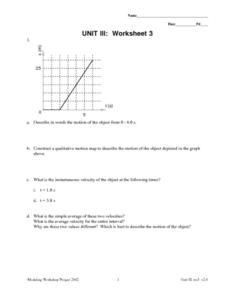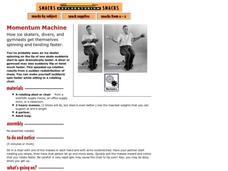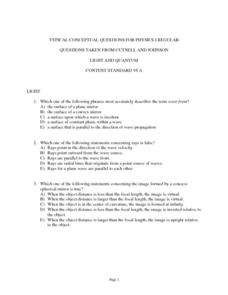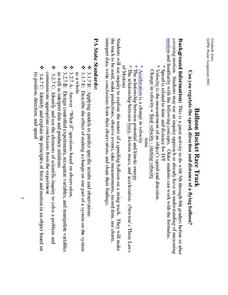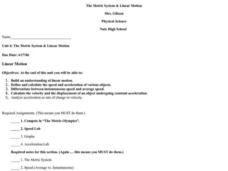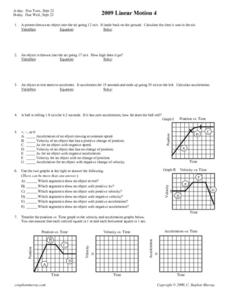Curated OER
Linear Motion Problems
In this motion worksheet, learners determine the speed, velocity, or acceleration of various objects under certain conditions. This worksheet has 7 word problems.
Curated OER
Unit III: 3
In this unit III: 3 worksheet, students describe motion in words and graph drawings. Students calculate the instantaneous velocity and average velocity. Students also graph the displacement of the object in the word problems.
Curated OER
Momentum Worksheet
Young Newtons solve nine momentum problems on a physics homework assignment. They tell which moving object has more momentum, compute average force, determine velocity, and more. Using this resource, you can assess your physics pupils'...
Exploratorium
Momentum Machine
If you have a rotating office chair in your classroom, you can have physics pupils participate in this simple, yet effective demonstration of angular momentum. One partner sits in the chair, arms outstretched, holding heavy weights. The...
Bowels Physics
Refraction and Lenses
Every object we see must pass through a lens, but how does each individual's lens differ? Learners explore the science behind refraction and lenses, uncovering the details that allow them to perform daily activities.
It's About Time
A Moving Frame of Reference
We often remind pupils to cite their references, but this lesson helps them understand there are many frames of reference. Scholars experiment with throwing a ball straight up in the air and catching it. Then they must do it again while...
EZ Task
Forces
Investigate force, acceleration, Newtons, and vectors with this learning exercise packet that starts with an overview fact sheet for reference. Learners label images as either push or pull forces, indicating if the force causes a change...
It's About Time
Circular Motion
Lead your class in this exciting activity to learn more about motion and its importance. Pupils learn about a centripetal and why it is required to maintain a constant speed in a circulating moving mass. They apply the equation for...
Curated OER
Technology for Studying Comets
Students design an Aerogel model to capture clay particles. In this space science lesson plan, students discover what happens to comets as they hit a surface. They explain how the Aerogel technology would help scientists study comets...
Science 4 Inquiry
Fluid Streams Affecting Weather
The jet stream can reach speeds of up to 250 miles per hour. Scholars learn about the jet stream and ocean currents as they rotate through stations. They answer questions leading them to understand the impact these fluid streams have on...
Curated OER
Typical Conceptual Questions for Physics I - Light and Quantum
This is a stellar overview of everything light and quantum! There are 30 multiple choice questions, none of them requiring any mathematical computation. There are a few diagrams to analyze: light rays striking reflective and refractive...
Curated OER
Newton's Second Law of Motion with Simple Machines
First graders study Newton's Second Law of Motion before demonstrating the concept with a simple machine. They sing a song about speed, force, mass, and acceleration. They use simple machines to demonstrate how objects that have a higher...
Curated OER
Speed of Light
In this speed of light worksheet, students read about Danish Astronomer ole Roemer and his discovery of the speed of light. Students complete 4 short answer questions based on the reading.
Curated OER
Motion
Sixth graders read about and study motion. They conduct a lab in which they calculate speed using track records at their school. They graph the results and then invite a guest speaker (an officer from the local police department) who...
Curated OER
Conservation of Momentum
In this momentum instructional activity, students calculate the velocity, distance traveled, or speed for different objects. This instructional activity has 10 different word problems.
Curated OER
TE Activity: Super Spinners!
Young scholars make spinners to investigate rotational inertia, rotational speed, angular momentum, and velocity. They make two sets of spinners that have different mass distributions and shapes. They complete a worksheet while...
Curated OER
Balloon Rocket Race Track
Students discuss "How can we measure (or make it easier to record) the speed, distance or acceleration of the balloon?" They told that they are going to make a balloon racetrack. Pupils use meter sticks to accurately measure length and...
Curated OER
Linear Motion
Students are able to build an understanding of linear motion. They are able to define and calculate the speed and acceleration of various objects. Students are able to differentiate betweeen instantaneous speed and average speed. They...
Curated OER
Linear Motion in Class Test Review
In this linear motion worksheet, students answer 21 questions about acceleration, velocity, position and time. Students interpret graphs of position vs. time, velocity vs. time and acceleration vs. time. They calculate speed of objects,...
Curated OER
Linear Motion 6
In this linear motion learning exercise, students answer 12 questions about acceleration, velocity and distance traveled. They interpret diagrams and indicate the location of an object if it has positive, negative or no acceleration....
Curated OER
Some Acceleration Practice Problems
In this acceleration worksheet, students practice determining acceleration, distance traveled, velocity and time given 5 problems with different scenarios.
Curated OER
Momentum
In this momentum worksheet, students solve 6 problems including finding the momentum of objects given their mass and velocity and applying the concepts of the conservation of momentum to solve for the speed and direction of moving objects.
Curated OER
"Measurement in Motion"
Ninth graders examine the rate of motion and changes in motion using a ramp and a rolling object. They conduct the demonstration, determine the average speed, and describe how a moving object can have zero acceleration and deceleration.
Curated OER
Linear Motion 4
In this linear motion worksheet, high schoolers answer 12 questions including finding acceleration of moving objects, calculating distance objects travel and determining the time of travel. Students interpret graphs of position vs. time,...



